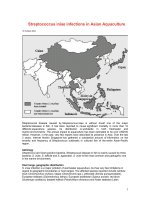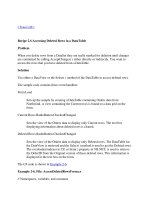Tài liệu Streptococcus iniae infections in Asian Aquaculture ppt
Bạn đang xem bản rút gọn của tài liệu. Xem và tải ngay bản đầy đủ của tài liệu tại đây (351.56 KB, 14 trang )
Streptococcus iniae infections in Asian Aquaculture
10 October 2003
Streptococcal disease caused by Streptococcus iniae is without doubt one of the major
bacterial diseases in fish. It has been reported to cause significant mortality in more than 12
different aquaculture species. Its distribution is worldwide in both freshwater and
marine environments. The annual impact to aquaculture has been estimated to be over US$100
million. However, in the past, very few reports have described its presence in Asia. Over the last 3
years, Intervet Norbio Singapore has gathered a substantial amount of information on the severity
and frequency of Streptococcus outbreaks in cultured fish of the entire Asian-Pacific region.
Aetiology
Streptococci are Gram-positive bacteria. Streptococcal disease in fish is mainly caused by three
bacteria: S. iniae, S. difficile and S. agalactiae. S. iniae is the most common and pathogenic one in
the marine environment.
Host range, geographic distribution
S. iniae infection is a major problem of warmwater aquaculture, but has very few limitations in
regard to geographic boundaries or host ranges. The affected species reported include rainbow
trout (Oncorhynchus mykiss), tilapia (Oreochromis spp.), yellowtail (Seriola quinqueradiata),
European seabass (Dicentrarchus labrax), European seabream (Sparus aurata), red drum
(Sciaenops ocellatus), bastard halibut (Paralichthys olivaceus) and Asian seabass (Lates
calcarifer).
1
The following map shows the countries of Asia where Intervet has isolated S. iniae from cultured
fish to date.
In these countries, S. iniae has been isolated in a variety of species as illustrated in the following
table.
Fish species Country of isolation Asian seabass/Barramundi (Lates calcarifer) Malaysia, Singapore,
Taiwan, Indonesia, Thailand Malaysia Malaysia, China Pomfret (Trachinotus spp.) Malaysia,
Epidemiology
The transmission is horizontal with infection coming from direct contact with infected fish,
contaminated fish food or a contaminated environment. As Streptococci bacteria can
survive for several months in frozen fish, feeding trash fish considerably increases the
chances of infection. Transmission from wild fish to cultured fish has also been reported.
Both acute and chronic mortality occurs. Acute outbreaks often occur during the warmer
months of the year or when fish are subject to increased stress, with cumulative mortality
reaching 80% within a 10-day-period. In a marine cage-farming situation, the peak
mortality usually starts suddenly from one cage and spreads progressively to the
neighbouring cages as illustrated in the following graph.
Fish species Country of Isolation
Asian seabass/Barramundi
(Lates calcarifer)
Malaysia, Singapore, Taiwan, Indonesia
Thailand
Four-finger threadfin
(Eleutheronema tetradactylum)
Malaysia
Grouper
(Epinephelus spp.)
Malaysia, China
Pomfret
(Trachinotus spp.)
Malaysia, China
Seabream (Rhabdosargus spp.,
Sparus spp.: Plectorhynchus spp.)
China
Snapper
(Lutjanus spp.)
Malaysia, China
Tiliapia
(Oreochromis spp.)
Philippines, Indonesia, China
Yellow croaker
(Larimichthys polyactis)
China
2
After an acute outbreak, a low-level chronic mortality can carry on for weeks or months with a small
number of fish dying every day. Any size of fish can be affected by S. iniae. But most outbreaks will
take place on fish of at least 10 g.
Clinical signs and gross pathology
Usually, fish infected with S. iniae become lethargic and refuse to feed. As these bacteria target the
brain and nervous system, erratic swimming, disorientation and swirling behaviour are commonly
observed. Very often, fish show unilateral or bilateral exophthalmia with opacification of the cornea.
Petechial haemorrhage can be present at the base of the fins, or around the mouth, operculum or
anus. Darkening of the skin is another common external sign. Internally, the symptoms are typical
of a systemic bacterial infection with presence of ascites, splenomegaly, enlarged kidney, pallor
and haemorrhages of the liver.
Affected black Seabream (Spondyliosoma
cantharus wiht opacification of the cornea)
Diagnosis
Clinical signs and impression smear. The presence of typical clinical signs and demonstration of
Gram-positive cocci from internal organs by Gram-stained impression smears constitute a
presumptive diagnosis.
Bacteriology. Samples from brain, liver, spleen and kidney tissues plated on standard, nonselective
TSA or BHIA media supplemented with salt if appropriate, incubated at 26ºC for 24 to 48 hours
3
show small (0.5-1.0 mm diameter), whitish, translucent, rounded and slightly raised
colonies. Streptococci are Gram-positive, nonacid fast, non-motile, oxydase-positive, catalase
negative, cocci. S. iniae are ß-haemolytic. The identification to the species level is done on the
basis of biochemical and phenotypical profile.
Histopathology. Invasion of a large number of Gram-positive cocci can be observed in most organs.
Proliferative inflammation with infiltration of macrophages engulfing bacteria and multifocal areas of
necrosis are particularly notable in the central nervous system, eye, heart, spleen, kidney and
ateral muscles. No notable changes are observable in the gills.
Control
Considering the acute nature of the development of the disease, most fish will not be treatable
through antibiotic treatment. Presently there is no real effective cure.
Prevention
Avoidance. Screening and quarantine of incoming fingerlings and avoiding the feeding of trash fish
diet are the two major means of avoidance relevant to Asia.
Good husbandry practices. Reducing overfeeding, overcrowding and unnecessary stress (such as
handling or transportation) can reduce the risk of outbreak. The collection and sanitary disposal of
moribund or dead fish should be observed on a daily basis. These measures may prevent
outbreaks or at least reduce their severity.
Vaccination. A safe and effective vaccine against S. iniae outbreak in fish has been developed
by Intervet Norbio Singapore and will soon be available in South East Asia as a major means to
control this disease.
Invasive Infection with Streptococcus iniae -- Ontario, 1995-1996
During December 1995-February 1996, four cases of a bacteremic illness (three accompanied by
cellulitis and the fourth with infective endocarditis, meningitis, and probable septic
arthritis) were identified among patients at a hospital in Ontario. Streptococcus iniae, a fish
pathogen not previously reported as a cause of illness in humans (1-3), was isolated from all four
patients. All four patients were of Chinese descent and had a history of preparing fresh, whole
fish; three patients for whom information was available had had an injury associated with
preparation of fresh, whole fish purchased locally. This report summarizes information about
these cases and presents preliminary findings of an ongoing investigation by health officials in
Canada (4), which suggests that S. iniae may be an emerging pathogen associated with injury
while preparing fresh aquacultured fish. Case Reports
The first three cases occurred during December 15-20, 1995, among previously healthy women
who ranged in age from 40-74 years. Each had a history of injury to the hand while preparing
fresh, whole, aquacultured fish. The first case-patient reported a puncture wound to her hand
with a fish bone while preparing a newly purchased tilapia (Oreochromis species) *, a freshwater
fish marketed primarily as whole fish; the second lacerated the skin over her finger with a knife
that had just been used to cut and clean a freshwater fish of unknown type; and the third
punctured her finger with the dorsal fin while scaling a fresh tilapia.
The period from injury to onset of symptoms for the three cases ranged from 16 hours to 2 days.
At the time of hospitalization, physical examination findings included fever (range: 100.4 F {38.0
C} to 101.3 F {38.5 C}) and cellulitis with lymphangitic spread proximate to the site of injury.
Leukocyte counts ranged from 12,900/mm3 to 16,900/mm3 with an increased proportion of
neutrophils. Blood cultures from all three patients were positive for S. iniae, and treatment with
beta-lactam antibiotics or clindamycin resulted in complete resolution of all manifestations of
illness.
4
The fourth patient, a 77-year-old man, was admitted to the hospital on February 1, 1996,
because of a 1-week history of increasing knee pain, intermittent sweats, fever, dyspnea, and
confusion. Past medical history included diabetes mellitus, hypertension, rheumatic heart disease,
chronic renal failure, Paget's disease, and osteoarthritis. Approximately 10 days before admission,
he had prepared a fresh tilapia, although it was unknown whether he incurred an injury while
preparing the fish. Findings on examination included temperature of 96.1 F (35.6 C) and a large
effusion and warmth of the right knee without overlying cellulitis. New murmurs of aortic
insufficiency and mitral regurgitation were noted. While in the emergency department, he had a
respiratory arrest and was intubated; treatment included administration of a beta-lactam agent
and erythromycin. The leukocyte count on admission was 25,200/mm3 with 95% neutrophils.
Ten hours following admission, his knee was aspirated, and a lumbar puncture was performed.
Analysis of the joint fluid included a leukocyte count of 72,000/mm3 but no evidence of crystals.
Analysis of the cerebrospinal fluid (CSF) included a leukocyte count of 87/mm3 (54%
neutrophils), a glucose of 14 mg/dL, and a protein of 320 mg/dL. Cultures of samples of synovial
fluid and CSF were negative, but blood cultures yielded S. iniae. Based on the clinical and
laboratory findings, and a transesophageal echocardiogram that documented a mitral-valve
vegetation, S. iniae endocarditis and meningitis were diagnosed. Treatment with beta-lactam
antibiotics was continued, and he recovered. Microbiology
Isolates from all patients grew on sheep-blood agar incubated in room air at 95.0 F (35 C),
appeared as gram-positive cocci in short chains or pairs, and were catalase-negative. During the
first 18 hours of incubation, colonies were alpha-hemolytic and initially were identified as viridans
streptococci. Further testing conducted by reference laboratories identified them as S. iniae.
Three strains were resistant to bacitracin, and the fourth was susceptible. Pulsed-field gel
electrophoresis patterns of chromosomal Sma1 digests of all four isolates were identical.
Microbroth-dilution testing for susceptibility indicated that all isolates were susceptible to beta-
lactams, macrolides, trimethoprim-sulfamethoxazole, and tetracycline. Follow-Up Investigation
All four patients had prepared fresh, whole fish, three of which were known to be tilapia, that
had been purchased from different stores. In two cases, the fish were taken live from holding
tanks in different fish markets. Surface cultures were obtained from four fresh tilapia purchased
at selected fish markets in the community during March 1996. Cultures from three of the four fish
yielded S. iniae; however, pulsed-field gel electrophoresis patterns were different for each, and
none matched the outbreak strain. None of the vendors at the markets where the fish were
purchased reported that the fish appeared to be sick. Fresh, whole tilapia sold in Ontario were
imported from U.S. fish farms.
The ongoing epidemiologic and microbiologic investigation includes the establishment of
surveillance for cases of upper-extremity cellulitis in patients visiting the emergency departments
of 10 Toronto-area hospitals and use of a standardized questionnaire for interviewing patients. In
addition, to better characterize the prevalence of S. iniae in fish, samples from live, aquacultured
fish imported into Canada are being collected and tested by Canadian health officials for S. iniae.
Reported by: M Weinstein, MD, DE Low, MD, A McGeer, MD, B Willey, Mount Sinai Hospital and
Princess Margaret Hospital, Univ of Toronto, and Canadian Bacterial Diseases Network, Toronto;
D Rose, MD, M Coulter, P Wyper, Scarborough Grace Hospital, Scarborough; A Borczyk, MSc,
Public Health Laboratory of Ontario, Toronto; M Lovgren, National Reference Center for
Streptococcus, Laboratory Center for Disease Control, Edmonton, Alberta, Canada. Childhood and
Respiratory Diseases Br, Div of Bacterial and Mycotic Diseases, National Center for Infectious
Diseases, CDC.
Editorial Note
5









